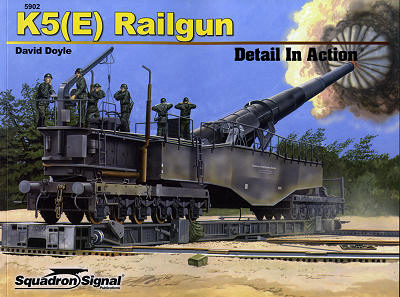 Despite being
somewhat of a relic of WWI, the rail gun has been something that has fascinated
many military weapons enthusiasts. Despite some of the disadvantages of such a
gun (ease of movement and the ability to operate it anywhere are not highlights
of these behemoths), they had considerable use and were operated in Russia,
France and Italy. There, their effect was feared by those on the receiving end
of their huge 280 mm shells.
Despite being
somewhat of a relic of WWI, the rail gun has been something that has fascinated
many military weapons enthusiasts. Despite some of the disadvantages of such a
gun (ease of movement and the ability to operate it anywhere are not highlights
of these behemoths), they had considerable use and were operated in Russia,
France and Italy. There, their effect was feared by those on the receiving end
of their huge 280 mm shells.
Krupp built 24 of these and they were initially deployed to
assist in the invasion of Great Britian, where their 30 mile range could easily
reach the coast from the more narrow parts of the English Channel. Eventually
the guns (two to a unit) were deployed elsewhere as they were needed when the
war progressed.
I'm sure that moving and setting up one of these guns wasn't an
easy task. There was a huge crew of gunners and engineers responsible for the
gun's operation. This wasn't something you left on the tracks and fired. A large
firing circle needed to be set up to allow for changes in azimuth as the gun was
unable to do that on its own. Its sheer size made it difficult to hide and while
there were special reinforced bunkers built to house these guns when not in
operation, often they relied on tunnels.
What is really amazing is that any survived the war. While many
were captured by the advancing Allies, most were reduced to scrap. One is at the
US Army Ordinance Museum, captured at Anzio while the other is left to rust away
at a Normandy museum.
This is the second 'Detail in Action'
book and these are for subjects that have too little
information on them for either an In Action or a Walk-Around book. Both are
combined into one cover with this series. Like others in the two series, this
is basically a photo book and there are lots of photos included. Aside from the
history of the vehicle, there are walk-around studies of the two extant guns,
each of which have bits and pieces the other does not. This means a lot of color in
this volume which is always a good thing. Author David Doyle has done a nice job
of bringing together the history and photos of this big gun. The photos in the
'in action' portion are all period images. I did find some repetition in the
photo captions, but I guess one can only say the same thing so many ways.
All in all, it is a great way to highlight these sorts of
subjects and I'm quite pleased that Squadron/Signal has chosen this route rather
than to ignore the subject altogether. It makes for a superb book and is one
that I know you will find interesting and useful.
August 2011
My thanks to Squadron Products for the review copy. Get yours
today at your favorite shop or on-line retailer.
If you would like your product reviewed fairly and quickly, please contact me or see other details in the Note to Contributors.
 Despite being
somewhat of a relic of WWI, the rail gun has been something that has fascinated
many military weapons enthusiasts. Despite some of the disadvantages of such a
gun (ease of movement and the ability to operate it anywhere are not highlights
of these behemoths), they had considerable use and were operated in Russia,
France and Italy. There, their effect was feared by those on the receiving end
of their huge 280 mm shells.
Despite being
somewhat of a relic of WWI, the rail gun has been something that has fascinated
many military weapons enthusiasts. Despite some of the disadvantages of such a
gun (ease of movement and the ability to operate it anywhere are not highlights
of these behemoths), they had considerable use and were operated in Russia,
France and Italy. There, their effect was feared by those on the receiving end
of their huge 280 mm shells.